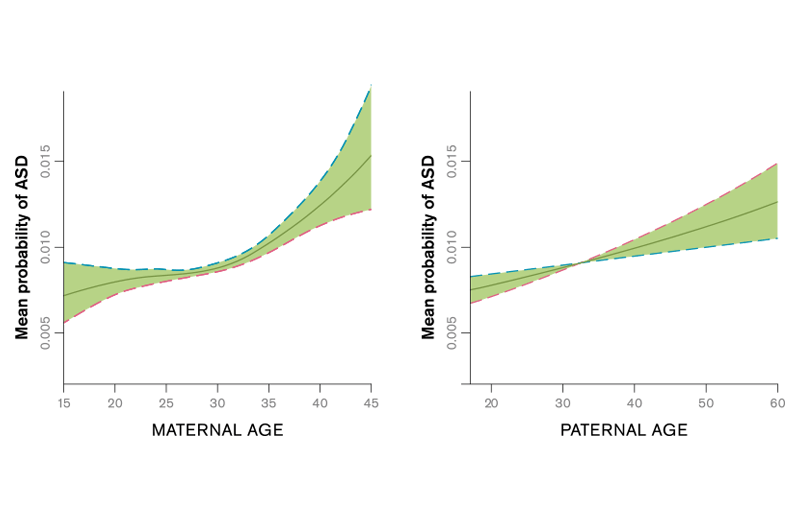Child's Autism Risk Accelerates with Mother's Age Over 30
 By Rachel Ewing
By Rachel Ewing

- Drexel Selects New, World-Class Life Sciences Building at 3201 Cuthbert Street for Medical Research Operations
- Breakthrough on Gene Therapy for Hereditary Spastic Paraplegia
- Drexel Environmental Collaboratory Releases Cross-Sector Findings on Severe Weather Recovery Challenges
- Drexel Launches the Manuel Stamatakis Center for Alternative Investments at the LeBow College of Business

Older parents are more likely to have a child who develops an autism spectrum disorder (ASD) than are younger parents. A recent study from researchers from the Drexel University School of Public Health in Philadelphia and Karolinska Institute in Sweden provides more insight into how the risk associated with parental age varies between mothers’ and fathers’ ages, and found that the risk of having a child with both ASD and intellectual disability is larger for older parents.
In the study, published in the February 2014 issue of the International Journal of Epidemiology, researchers report that fathers’ and mothers advancing ages have different impacts on their child’s risk. The rise in ASD risk with parental age was greater for older mothers as compared to older fathers.
“The open question at hand really is, what biological mechanisms underlie these age effects?” said Brian K. Lee, PhD, an assistant professor in the Drexel University School of Public Health and research fellow of the A.J. Drexel Autism Institute, and senior author of the study. The observed differences in risk based on mothers’ and fathers’ ages point to a need to continue investigating underlying mechanisms of ASD that may be influenced by a mother’s age, Lee said, even though much recent discussion has focused on fathers’ and even grandfathers’ ages.
The risk of having a child with ASD had a more complicated relationship to age in women than in men – whose risk of fathering a child with ASD increased linearly with age across their lifespan. Among women giving birth before the age of 30, the risk of ASD in the child showed no association with age -- it was simply very low. But for babies born to mothers aged 30 and older, the chance of developing ASD rose rapidly with the mother's age.
Lee noted that the non-linear maternal age effect that is relatively stronger than the paternal age effect on ASD risk has been observed in previous studies, but has not received much attention.
Multiple mechanisms could be in play to account for the different patterns of risk, including environmental risk factors occurring in women after age 30. Factors such as complications in pregnancy could also underlie the effect of mothers’ ages on a child’s ASD risk but not a paternal age effect. The linear, steady increase in risk associated with fathers’ ages is consistent with the hypothesis of increased genomic alterations over the father’s lifespan that can increase risk of ASD, Lee said.
In this study, Lee and colleagues analyzed a large population registry sample of 417,303 children born in Sweden between 1984 and 2003, adjusted for numerous possible factors that could vary with parental age and also influence risk, such as family income and each parent’s psychiatric history. The study also used a particularly comprehensive case-finding approach, to identify more ASD cases than other studies might, based on all pathways to care in a socialized health system.
A goal was to study these parental age effects in more detail by looking at possible differing risks of ASD with and without intellectual disability – one of the most serious comorbid diagnoses with ASD, with a significant impact on functional status in life. This was the first population-based study with an ASD sample large enough to study ASD risk in populations of children with and without intellectual disability.
“When considering risk factors, we can’t necessarily lump all ASD cases together, even though they fall under a broad umbrella of autism,” Lee said. “We need to keep an open mind in case intellectual disability might be a marker of a different underlying mechanism.”
The finding that ASD with intellectual disability had a stronger association with older parents, compared to ASD without intellectual disability, supports continued investigation of possible different mechanisms.
Lee noted that, although age effects are important indicators of risk at the population level that could eventually help researchers identify preventable causes of disability, they aren’t very significant for a couple’s family planning because the overall risk remains low. “The absolute risk of having a child with ASD is still approximately 1 in 100 in the overall sample, and less than 2 in 100 even for mothers up to age 45.”
Drexel News is produced by
University Marketing and Communications.